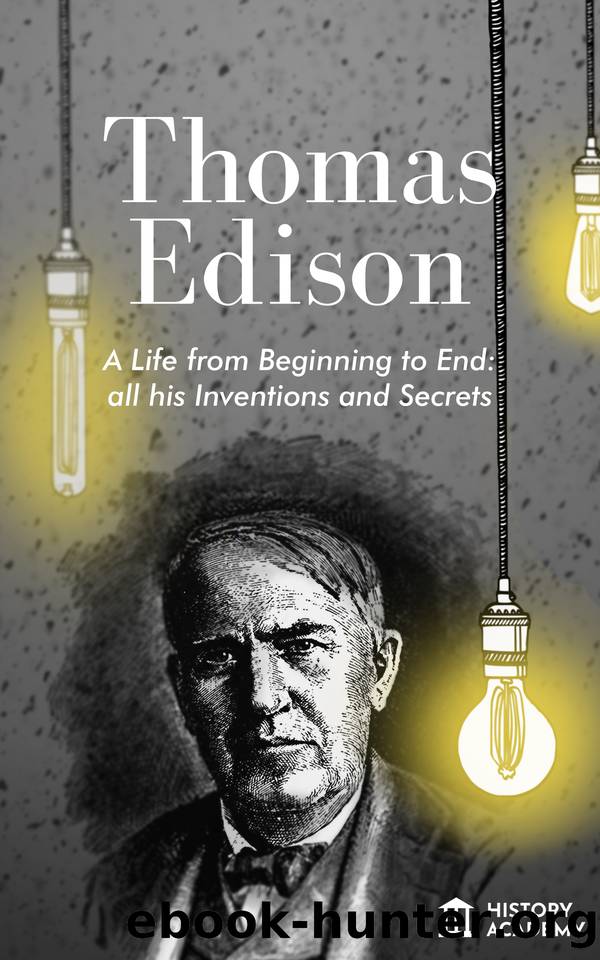Thomas Edison Biography: a Life from Beginning to End, with all his Inventions and Secrets (Italian Edition) by Academy History

Author:Academy, History [Academy, History]
Language: ita
Format: epub
Published: 2020-07-07T16:00:00+00:00
CHAPTER TEN: THE BOSTON LIFE
Due to the fact that it was constant, continuous work, which interfered with the studies and inquiries that could be carried out in the intervals of ordinary commercial telegraphy, Edison had a dissatisfaction with taking press reports. In some way, he wasn't lazy. Though he did not have a very lively interest in a telegraph office's pure routine work, he had the deepest curiosity about the basic electricity concepts that made telegraphy possible, and he had an unflagging ambition and confidence in his ability to improve the equipment that he worked every day. In this shy, awkward, studious youth, completely oblivious to clothes and personal appearance, but ready to spend his last dollar on books and scientific paraphernalia, Boston's entire intellectual environment was favorable for the creation of the brooding genius. It's a matter of record he once bought a new suit in Boston for thirty bucks, but the suit was ruined on the following Sunday while playing with acids in his little laboratory. "That's what I get for putting so much money into a new suit" was the youth's laconic comment, who was more than happy to pick up an entire collection of Faraday's works about the same time. Adams says that Edison took those books home at 4 a.m. He read continuously before breakfast, and then, enthusiastically, he remarked: "Adams, I've got so much to do and life is too short, I'm going to hustle." Then he began running for breakfast.
Edison himself says: "It was in Boston that I purchased the works of Faraday. I believe I must have done everything in those books. His theories were simple. He did not use algebra. He was the Master Experimenter. I don't think there were many copies of Faraday's works sold in those days. The only people who did anything in electricity were the telegraphers and the opticians who made a simple school appeared. In 1852 Mr. Hall made for a Dr. A. L. Henderson of Buffalo, New York, a model line of railroad with an electric-motor engine, telegraph line, and electric railway signals, along with a figure that automatically controls the signals at each end of the line. This was the first example of railroad trains moving by telegraph signals, a practice that is now so normal and ubiquitous that it attracts no attention. To show how little some basic approaches can alter in fifty years, it can be remembered that Hall transported the current across forty feet of rail to his tiny car, using the rail as a conductor, just as Edison did more than thirty years later in his historic experiments at Menlo Park for Villard; and just as a large proportion of American trolley systems do at this moment.
Edison was very much at home with such practical, investigating people like these. Another prominent man of this stamp, with whom Edison was put in contact, was the late Mr. Charles Williams, who, starting his career in the electrical sector in the 1940s, was
Download
This site does not store any files on its server. We only index and link to content provided by other sites. Please contact the content providers to delete copyright contents if any and email us, we'll remove relevant links or contents immediately.
Hit Refresh by Satya Nadella(8866)
When Breath Becomes Air by Paul Kalanithi(8043)
The Girl Without a Voice by Casey Watson(7607)
A Court of Wings and Ruin by Sarah J. Maas(7278)
Do No Harm Stories of Life, Death and Brain Surgery by Henry Marsh(6690)
Shoe Dog by Phil Knight(4899)
Hunger by Roxane Gay(4681)
A Higher Loyalty: Truth, Lies, and Leadership by James Comey(4559)
The Rules Do Not Apply by Ariel Levy(4530)
Everything Happens for a Reason by Kate Bowler(4481)
Tuesdays with Morrie by Mitch Albom(4411)
The Immortal Life of Henrietta Lacks by Rebecca Skloot(4264)
How to Change Your Mind by Michael Pollan(4115)
Millionaire: The Philanderer, Gambler, and Duelist Who Invented Modern Finance by Janet Gleeson(4113)
All Creatures Great and Small by James Herriot(3993)
Tokyo Vice: An American Reporter on the Police Beat in Japan by Jake Adelstein(3867)
Elon Musk by Ashlee Vance(3861)
The Money Culture by Michael Lewis(3857)
Man and His Symbols by Carl Gustav Jung(3847)
